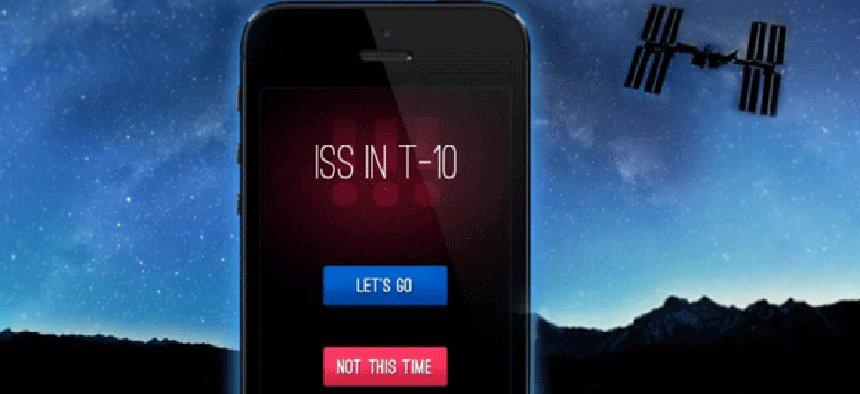'Largest hackathon ever' gives NASA a new payload of space apps


Connecting state and local government leaders
More than 9,000 people representing 44 countries took part in the agency's challenge, producing 770 entries and five overall winners.
NASA has named the five best in class winners of its second annual International Space Apps Challenge, which include technology for growing spinach on Mars and helping astronauts save time when taking photographs from space.
More than 9,000 people and 484 organizations from 83 cities across 44 countries competed the April 20-21 challenge, which Nick Skytland, program manager for NASA’s Open Innovation Program, described as the “largest hackathon ever held.”
“Our space program, more than ever, requires the active engagement of the public to co-create our future. This weekend demonstrated the true potential of participatory exploration and what can happen when a government agency like NASA takes a chance on engaging the untapped, unexpected and uncharted know-how of thousands of passionate citizens around the world,” Skytland wrote in a blog post.
Participants developed software, hardware, data visualizations and mobile or Web applications in one of 58 challenge categories designed to contribute to space exploration missions and help improve life on Earth. Of the 770 submissions, 133 were nominated for global judging by NASA, the European Space Agency and other partner organizations.
The five best in class winners are:
Most inspiring: T-10, a mobile application from a London-based team that helps astronauts take photographs.
Astronauts choose a location they wish to photograph, whether they want a day or night photo, and T-10 alerts them 10 minutes before the space station is set to fly over the location. If visibility is bad, no alert is given. Earth-based T-10 users can also be notified when the station is visible in their area. Additionally, if an astronaut tells the program he will take a photograph, T-10 users are notified and they can indicate if they will wave at the ISS when it passes overhead, and the astronaut's countdown screen updates to show the number of people ready to wave.
Best use of data: Sol, an interplanetary weather application for smart phones and tablets from a team based in Kansas City, Mo., that integrates weather data from the Curiosity rover on Mars with Earth weather data.
The application aims to generate mass consumer appeal in science and, more specifically, NASA’s Mars mission. The Sol team also built the Mars Atmospheric Aggregation System API, used to fuel several of the Mars weather applications produced during the challenge.
Best mission concept: Popeye on Mars, a deployable, reusable spinach greenhouse for Mars.
Developed by a team in Athens, Greece, the fully self-contained aeroponic system operates for 45 days and includes systems for harvesting both the plants and the oxygen produced, photovoltaic power panels, internal environment stabilization and protection against extreme Mars conditions.
Best use of hardware: ISS Base Station, which combines software tracking the position of the International Space Station, allowing the user to find the station in the sky, with a physical pointer that points to the base station’s current location and lights up when the station is in the user’s area.
Built by a Philadelphia-based team, the co-design project expands on the Spot the Station Web app.
Galactic impact: Greener Cities, which crowdsources microclimate data through low-cost sensors and network connectivity in urban gardens.
The project, developed by a team in Gothenburg, Sweden, seeks to complement NASA satellite climate data and encourage children’s interest in programming and the environment. The aggregated information can be used by city officials to monitor air quality on a neighborhood level and by scientists to gain deeper insights related to global climate.
Regular folks also voted for their favorite projects. The solution with the most public votes, ChicksBooks, received the People’s Choice Award. Developed in Sofia, Bulgaria, ChicksBook is a Web, Android and iOs application to help users learn how to raise chickens and manage the data for a backyard farm.
NASA has yet to decide which of the apps it will adopt, reported the Verge, although at least two apps from last year’s hackathon are currently in use at the agency. One converts the image file format VICAR — used by many NASA employees — to PNG format, and the other is a software platform for NASA’s underwater robotic submarines.
NASA estimates that 60 percent of the participants in Space Apps had professional qualifications, a number Skytland estimates as being worth about a $14 million in man hours, the Verge reported. By comparison, Space Apps’s organizers spent $70,000 on the project.
Crowdsourcing is becoming an increasingly popular way for government agencies to gather information and services from experts and the public. Jacob Parcell, manager of Mobile Programs at General Services Administration’s Office of Citizen Services and Innovative Technologies’ (OCIT) Digital Services Innovation Center, has organized monthly Mobile Gov Wikithons, for example.
The Wikithons, usually scheduled at public spaces such as a local coffee shop, focus on areas of the MobileGov Wiki that needs the most work and provide a venue for attendees to give and get advice from one another on current projects or dilemmas. MobileGov Wiki is a compilation of material from the MobileGov Blog, an open, best practices resource exchange on mobile government created by OCIT to help agencies develop mobile services.
More information on the International Space Apps Challenge is available at http://spaceappschallenge.org

NEXT STORY: Data.gov expands toolkit for citizen developers




